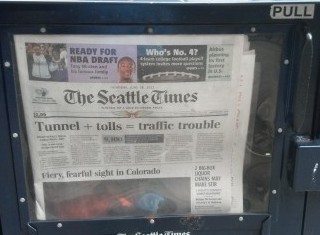 For Seattle traffic-watchers, Mike Lindblom at the Seattle Times has the most important story of the month: the news that a new state traffic study predicts that high rush hour tolls on the Alaskan Way Viaduct tunnel will divert 9,100 cars into downtown Seattle during the afternoon commute. For those of you who are counting, that’s a diversion rate of about 42 percent.
For Seattle traffic-watchers, Mike Lindblom at the Seattle Times has the most important story of the month: the news that a new state traffic study predicts that high rush hour tolls on the Alaskan Way Viaduct tunnel will divert 9,100 cars into downtown Seattle during the afternoon commute. For those of you who are counting, that’s a diversion rate of about 42 percent.
The Times editors considered it a bombshell. It was the day’s top story, above the fold, with a huge headline.
But here’s the thing: it’s not really news. Well, it’s only sort of news. I mean, there really was a new tolling study on the Viaduct, and it really did predict that lots of drivers would avoid the tolls by driving on surface streets. Yet the new study reached almost exactly the same conclusion that WSDOT itself reached last year. Here’s a quote from the transportation technical report appended to WSDOT’s 2011 Final Environmental Impact Statement:
Tolling would cause vehicles to divert from SR 99 to other nearby roadways…the bored tunnel is expected to result in a daily diversion rate of about 40 percent for all vehicle classes.
When the EIS first came out, I tried to draw attention to what the numbers showed: that the state’s own traffic models predicted that a tolled tunnel would lead to a traffic morass. Yet there were no bombshell headlines back then. Look for yourself in the Seattle Times online archives: the closest story was this, which only reported on the issue as if it were a “he-said-she-said” story.
I have to wonder why the Times editors consider today’s news a revelation worthy of the front page, while the same news last year got buried. I suspect it’s part of a regrettable human foible: in context of a political campaign or a hotly contested public policy controversy, people view facts as weapons for winning arguments, rather than as a means for discovering the truth. When emotions run hot, the press tends to evaluate factual claims for how they’ll affect each side’s political fortunes, not for whether they’re important or true.
Now that the the political controversy has subsided, the press can once again cover the facts about the Viaduct a little more rationally: weighing their validity and exploring the implications. Better late than never I suppose. Still it’s a shame: just when the public was in greatest need of solid facts, the press seemed more focused on the politics than the substance.

Comments are closed.